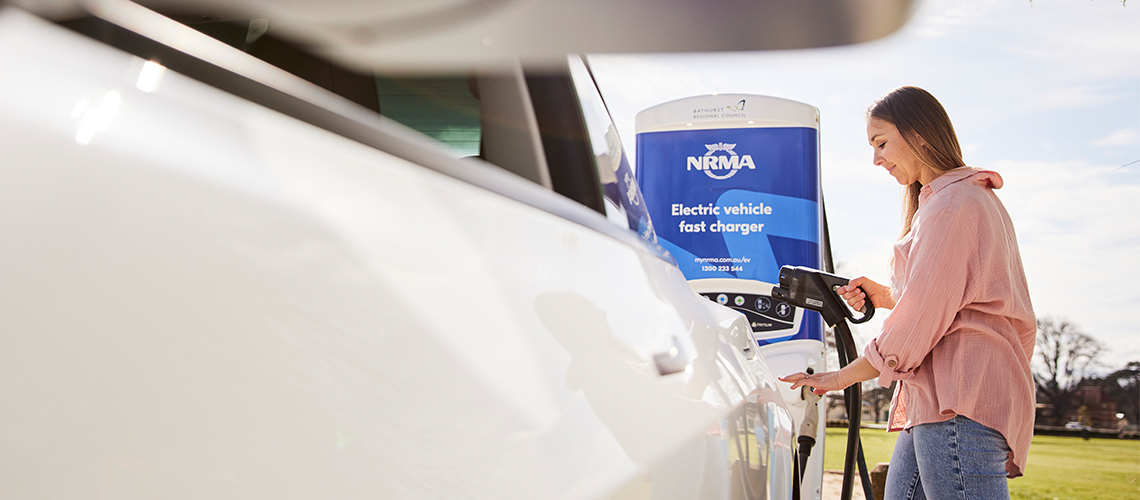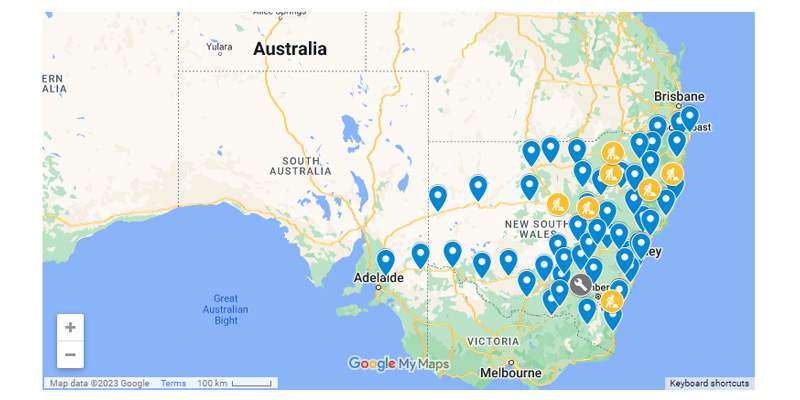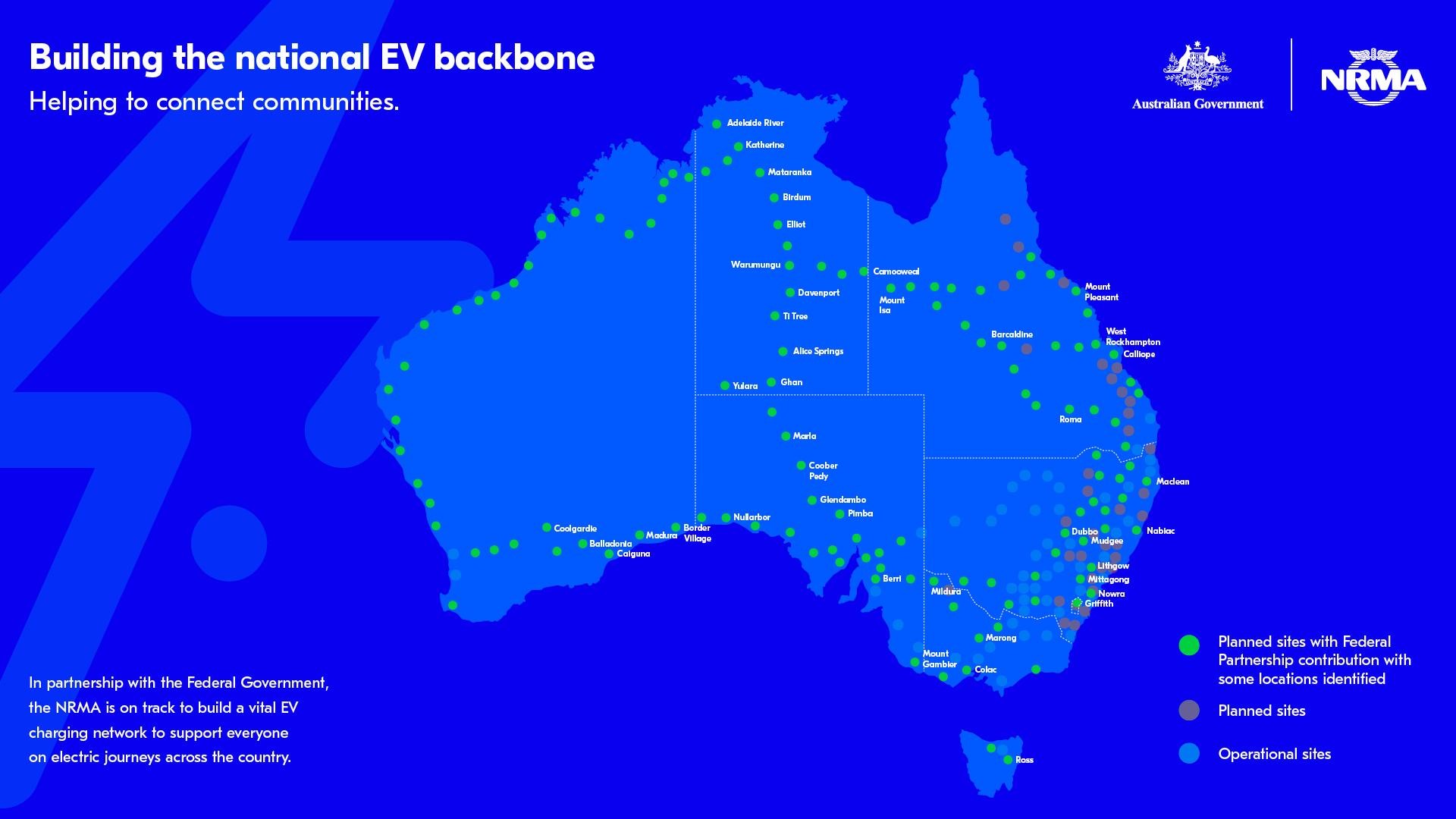


How is the NRMA powering Australia’s EV transition?
The NRMA has already begun rolling out EV charging infrastructure, building on its long history of working to make roads and vehicles safer and better for the people of New South Wales.
There are currently 50 sites stretching from Ewingsdale near Byron Bay in the state’s north to as far west as Tanunda in South Australia.

Map of NRMA charging network
With the announcement of the first NEVS by the federal Labor government on 19 April, the NRMA can now reveal that its charging network will expand with additional sites nationwide. Each of these sites will be around 150km apart, forming the 'backbone' of an EV charging network for Australians.
As noted by Minister for Climate Change and Energy Chris Bowen during Channel 7's Sunrise this week, the new network will help to make access to EV chargers more equitable for more Australians.
“I do understand a lot of Australians would look at buying an EV, but I think, you know, "I'd like to go for a long drive to the coast; will there be enough charging?" or "I live in the bush; will there be enough charging?"” said Bowen.
“At the moment, there isn't, but we are fixing that. We've got a policy of putting in a fast charger once every 150 kilometres on the highway.
"I'll be saying more about that pretty soon; we've got other announcements coming about charging. The private sector is stepping up, and NRMA is doing a great job on charging.”
The $80-100 million national network rollout will see around 130 fast charging sites made up of four bays and up to 400kw capacity, developed across the national highway network, connecting regional communities with the necessary infrastructure to support the increasing uptake of EVs.
The sites will consist of a mixture of fast-charging units from different suppliers. The site designs will differ from current locations and be fit for purpose.
The new rollout map announced by the federal government this week consists of a number of sites as per the map below:

The current list of site names 122 new locations in all states and territories of Australia:
| ACT | NSW | NT | QLD | SA | TAS | VIC | WA |
| Griffith | Armidale | Adelaide River | Augathella | Berri | Ross | Colac | Balladonia |
| Balranald | Alice Springs | Barcaldine | Border Village | Deloraine | Marong | Broome | |
| Coonabarabran | Baines | Bowen | Burra | Mildura | Caiguna | ||
| Dubbo | Birdum | Calliope | Ceduna | Port Fairy | Cataby | ||
| Glen Innes | Davenport | Camooweal | Coober Pedy | Sale | Coolgardie | ||
| Hay | Delamere | Christmas Creek | Coorabie | Sea Lake | Eighty Mile Beach | ||
| Holbrook | Elliot | Cloncurry | Glendambo | Shepparton | Eneabba | ||
| Jerilderie | Ghan | Dalby | Kimba | Fitzroy Crossing | |||
| Lithgow | Katherine | Dingo | Marla | Geraldton | |||
| Maclean | Mataranka | Emerald | Mount Gambier | Halls Creek | |||
| Mittagong | Ranken | Eumundi | Nullarbor | Kununurra | |||
| Moree | Tablelands | Gin Gin | Nuriootpa | La Grange | |||
| Mudgee | Ti Tree | Goondiwindi | Pimba | Lake Argyle | |||
| Nabiac | Warumungu | Gregory | Port Augusta | Lake Macleod | |||
| Narrarbri | Yulara | Hughenden | Port Gibbon | Madura | |||
| Narrandera | Innisfail | Port Pirie | Manjimup | ||||
| Nowra | Julia Creek | Portkefield | Merredin | ||||
| Parkes | Kynuna | Wudinna | Nerren Nerren | ||||
| Richmond Hill | Longreach | Yunta/ Manna Hill |
Norseman | ||||
| Scone | Maryborough | Northam | |||||
| Tamworth | Maxwelton | Pardoo | |||||
| Tenterfield | Miles | Peedamulla | |||||
| Wagga Wagga | Morven | Port Headland | |||||
| Wallsend | Mount Isa | Roebourne | |||||
| West Wyalong | Mount Pleasant | Southern Cross | |||||
| Yass | Roma | Warmun | |||||
| St Lawrence | Willare | ||||||
| Stanthorpe/ Warwick |
Wooramel | ||||||
| Tambo | Yannarie | ||||||
| Townsville | |||||||
| West Rockhampton | |||||||
| Winton |
The new EV strategy also opens the door to greater EV accessibility, affordability, and a significant drop in emissions, while focusing on expanding EV choice and improving affordability for buyers.
The strategy aims to achieve this by:
Fuel efficiency standards aim to limit the greenhouse gas emissions Australia’s fleet of car releases by creating a maximum average level of carbon emissions across a manufacturer’s overall car sales.
Australia already has voluntary fuel efficiency standards, but because they are not legislated, carmakers struggle to secure electric and other 'efficient' vehicle inventory. This situation is worsened by the nation competing with countries with legislated fuel efficiency standards and a more established demand for EVs.
Because of this, Australia has an EV supply issue rather than an EV demand issue.
As the NRMA notes in its submission to the NEVS consultation:
“A mandated CO2 standard is one of only few available options in the transport sector that will ensure abatement across the whole Australian light vehicle fleet to support the broader economy in achieving Net Zero 2050.”
In fact, it notes that transitioning the transport sector is a low-hanging fruit: “Reducing emissions in the transport sector can be achieved more easily than in most other sectors of the economy, particularly if the energy sector (specifically, electricity generation) continues to decarbonise.
“Leveraging the available opportunities in this sector is critical in ensuring the broader economy can support Australia’s international commitments to emissions reduction.”
Importantly, Australia’s fuel efficiency standards must be competitive with overseas jurisdictions if local arms of carmakers are to be able to secure more EVs.
Critically, the NRMA says mandated targets "must be ambitious" if Australia is to catch up with the global EV transition in a reasonable timeframe.
For this reason, the NRMA is calling for the government to:
The NRMA says that legislated standards should be periodically reviewed (e.g. every three years) to ensure they remain appropriate, fit-for-purpose, and continue to support vehicle choice for the consumer.